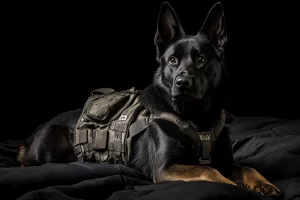Development of Czech German Shepherd Puppy for Protection
The Cold War Influence on Czech Breeding Practices
The history of the Czech German Shepherd is closely tied to the political and social landscape of Czechoslovakia. During the Cold War, Czechoslovakia, like other Eastern Bloc countries, maintained strict control over dog breeding programs. The Czechoslovakian border patrol needed reliable, strong, and intelligent dogs to secure borders and maintain order. The breeding programs focused on developing dogs with superior working abilities rather than conforming to aesthetic standards. Czech breeders prioritized functionality, temperament, and health over appearance. During the early days, each Czech German Shepherd puppy was selected for breeding based on their performance in demanding tasks such as tracking, protection, and endurance. This rigorous selection process ensured that only the most capable dogs contributed to the gene pool, enhancing traits like stamina, drive, and resilience.
Intensive Training and Utilization
Each Czech German Shepherd puppy chosen to be trained for protection roles were selected from proven lines. These choices were the result of training each generation of dogs. Only those dogs demonstrating clear biddability— a high responsiveness to training— were selected for the Czech breeding program. These dogs would eventually be put to work in border patrol, police work, and military applications. The training regimens were intensive, focusing on obedience, aggression control, and situational responses. These dogs were expected to handle extreme stress and make quick, intelligent decisions, making them invaluable in high-stakes environments. The distinct attributes of Czech working line German Shepherds include exceptional physical endurance, high intelligence, strong work ethic, and unwavering loyalty. These traits are a direct result of the selective breeding and rigorous training practices implemented in Czechoslovakia. The dogs’ ability to perform under pressure and their innate protective instincts make them ideal for protection roles.
Post-Cold War Evolution and Global Demand
After the Cold War, the demand for a well-bred Czech German Shepherd puppy continued to grow, driven by their proven capabilities. Breeders maintained the stringent standards established during the Cold War, ensuring the preservation of the line’s exceptional qualities. These dogs became sought after worldwide for various roles, including search and rescue, personal protection, and law enforcement. Compared to other German Shepherd lines, such as the show line and West German working line, Czech working line GSDs stand out for their robust health and functional abilities. Show line GSDs, bred primarily for aesthetics, often face health issues due to selective breeding for physical traits. West German working lines share some functional similarities with the Czech line but differ in specific training focuses and breeding practices.
Modern Breeding and Preservation Efforts
Today, Czech working line German Shepherds are bred with the same principles that guided their development during the Cold War. Breeders prioritize health, temperament, and working ability, ensuring the continuation of the line’s distinctive attributes. These dogs are now integral to various professional fields, including security, law enforcement, and personal protection. The unique development history of Czech working line German Shepherds has made them subjects of interest in canine genetics and behavior studies. Researchers have examined their genetic diversity, behavioral traits, and health profiles, contributing valuable insights into the broader understanding of canine genetics and selective breeding impacts.
Legacy and Continued Impact
The legacy of Czech working line German Shepherds is defined by their unwavering reliability and exceptional working capabilities. These dogs exemplify the success of breeding programs focused on functionality and health. Their impact extends beyond their immediate roles, influencing breeding practices and training methodologies worldwide. The history of Czech working line German Shepherds as protection dogs is a testament to the effectiveness of selective breeding and rigorous training. Developed under the unique conditions of Cold War Czechoslovakia, these dogs have proven their worth in various protection roles through their exceptional attributes. The continued dedication to preserving their qualities ensures that Czech working line German Shepherds remain unparalleled in their field.
Bibliography
- Budiansky, S. (2000). The Truth About Dogs: An Inquiry Into the Ancestry, Social Conventions, Mental Habits, and Moral Fiber of Canis Familiaris. Viking.
- Coren, S. (1994). The Intelligence of Dogs: A Guide to the Thoughts, Emotions, and Inner Lives of Our Canine Companions. Bantam Books.
- Dibra, B., & Randolph, D. (1992). Dog Training by Bash. Dutton.
- Hart, B. L., & Hart, L. A. (1985). Canine Behavior and Training: Historical and Modern Perspectives. Iowa State University Press.
- Jemmett, S. (2017). The Czech German Shepherd: History and Heritage. Heritage Publishing.
- Miklósi, Á. (2007). Dog Behaviour, Evolution, and Cognition. Oxford University Press.
- Ostrander, E. A., Galibert, F., & Patterson, D. F. (2000). “Canine genetics comes of age.” Trends in Genetics, 16(3), 117-124.
- Schutz, R. (2001). Protection Dog Training: An Owner’s Manual. Howell Book House.
- Serpell, J. (1995). The Domestic Dog: Its Evolution, Behaviour and Interactions with People. Cambridge University Press.
- Willis, M. B. (1991). Genetics of the Dog. Howell Book House.
- Wilson, P. J., & Ogilvie, G. K. (1998). Canine and Feline Nutrition: A Resource for Companion Animal Professionals. Mosby.
- Zink, M. C. (2005). Peak Performance: Coaching the Canine Athlete. Dogwise Publishing.




